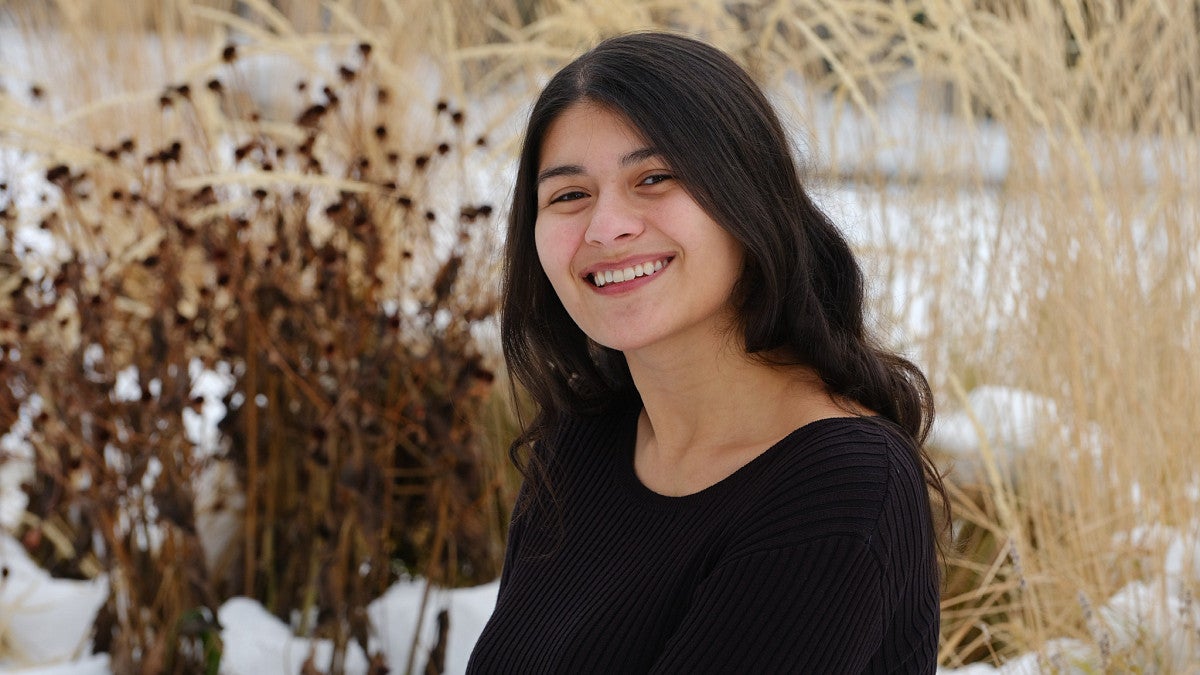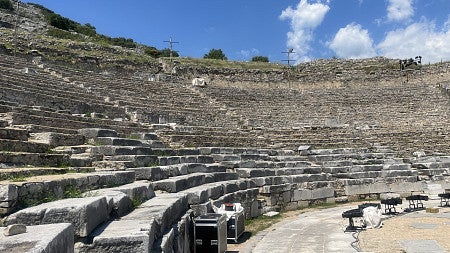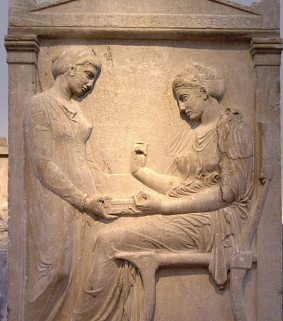
The Oregon Design Ducks (ODD) flock at the College of Design is made up of promising students, award-winning faculty, and passionate staff. The following profile is just one way our ODD flock is standing out and making its mark on the world.
Alexis Garcia is currently a graduate student in the Department of the History of Art and Architecture, where she also earned her bachelor's degree. Garcia is working towards a master's degree in Art History, Criticism, and Conservation. She is one of the 2021-22 recipients of the Gloria Tovar Lee Scholarship in Art History – an award earned by only the most promising students in the program. Garcia was selected to present her research at the highly prestigious Archaeological Institute of America (AIA) Annual Meeting. Last summer, she was able to attend the American School of Classical Studies Summer Seminar in Greece. Now, she's working to recover the voices of Ancient Greece's enslaved population.
The college and HAA had an opportunity to catch up with Alexis Garcia and learn about her experiences at the UO, what she's working on, and what is to come.
Here's what she had to say!
What made you realize that art history was what you wanted to study? Was there a particular moment in life that caused you to take this route?
I came to the University of Oregon as an anthropology major. I was really interested in people and wanted to be a cultural anthropologist, but as I made my way through the program, I realized I was more interested in objects and material things than ethnography. Over the winter break of my sophomore year, I took a trip to LA and visited the Getty Museum – one of the nicest museums in the United States. I was able to see incredible works of art from around the world, including a piece by Van Gogh. At that moment, I realized I might want to work in museums!
When I came back for the fall term, one of my favorite professors, Daphne Gallagher, taught a class on West African art and archeology. I fell in love with it. I realized in that course that Art History meshed the things I wanted to do – studying cultures and people through material items. Through pieces like art objects and artifacts, I could see a snapshot of a person, time, and place.
Now that you had a better idea of what you wanted to do in life, what was the deciding factor in staying at the University of Oregon to earn your master’s degree?
When I finished my undergrad, I felt uncertain about where I wanted to be. I did my undergrad here and I loved Eugene, but it is a very big decision. The deciding factor was the culture of the program at the UO. It’s highly supportive and collaborative. The faculty are attentive to your needs in a way that I know is not universal. My friend who made the decision to go to another school explained that it’s not this way everywhere. In her experience, the professors were more distant and less willing to help on a personal level. In my experience, the opposite has been true. My advisor [Associate professor] Kris Seaman has been very formative and influential in my journey, and she even helped me decide how I could specialize my research. Our department head, Akiko Walley always goes to bat for her students and ensures that our work is seen. All of the faculty in my department go above and beyond, and they are invested in our success as students.
Now that you’ve been studying it for nearly 6 years, what most interests you about Art History?
The zeitgeist of art. I am especially captivated by decoding what the people of the past were interested in. Art gives you the chance to do just that. A good example of this can be found in Renaissance art. A portrait of a woman from that time period can show you what fashions were being worn, how they wore their hair, even the furniture they had. It also communicates ideology – how did they want to depict the typical Renaissance woman? What was she ‘supposed’ to look like? You can reconstruct economic, social, and political culture through the iconography of the artwork, which is what is so appealing to me.
In the future, art historians will look at the contemporary art being created today and learn about us in the same way. You will be able to see what an artist was anxious about, what they found interesting or important socially, politically, economically, and much more. You can find this sort of thing throughout art history – for example, Surrealism partially arose from people coping with World War I. People historically have responded to things they or their society are feeling.
You earned the opportunity to present research into Ancient Mediterranean art and archaeology at the Archaeological Institute of America (AIA) Annual Meeting. Can you tell us a little bit about that experience?
Honestly, I was not expecting to get into the conference. As a graduate student with no professional experience at the time, I expected a quiet rejection letter. For classicists and archeologists, the AIA annual meeting is a big deal. It was a huge honor to be able to present my research at this stage. Unfortunately, I was catastrophically sick during the meeting, so I stayed home and presented virtually. Nonetheless, the opportunity to present my research and hear from others who work in similar fields was an incredible experience.
The Department of the History of Art and Architecture presents the Gloria Tovar Lee Scholarship in Art History to its most promising students. Why do you believe you were chosen to receive the award?
It’s hard to speculate on these things because it’s hard to compare how you feel about your feats to how other people do. I like to think it’s because, throughout my time in the program, I have demonstrated that I am active and driven, and that hopefully that my work has enough potential that they think it is worth funding.
Whatever the case, I am grateful for this award. It came in the fall of 2021, after an emotionally taxing year of Zoom school during lockdown. I had just graduated, my last semester was over zoom, and I was nervous about what school would even look like moving forward. This scholarship felt like a message to me that said, “We still believe in you. Even though things are changing, we still want you to be invested and have hope moving forward.” It was validating, reassuring, and it gave me the confidence that I needed to start school post-pandemic.
Last Summer, you had the opportunity to partake in the American School of Classical Studies Summer Seminar in Greece. Can you tell us a bit about that experience?

The concept of the trip was a “seminar-meets-archeology tour.” The first 4 days of the summer seminar were held in Athens, but the seminar was focused on Northern Greece. After four days, we hit the road and travelled up into ancient Macedon and Thrace, the part of the country that borders Bulgaria. We got to visit a lot of remote sites that were off the typical tourist track. There was homework and a rigorous presentation to prepare for, but a typical day in the seminar would also include a 2-mile hike to see an ancient theater, or driving out to lesser-known archaeology sites like Maroneia. I was even able to stand in the theater where Alexander the Great’s father was assassinated! Of course, we also saw more famous Greek hotspots like the Parthenon and Pella, but it was an incredibly unique experience to also visit these lesser-traveled historical sites.
The collaboration among the group was extremely beneficial. Most of the people who were there with me were specialized in one particular subject – some only studied ancient Greek philosophy, some studied Latin and Greek languages, and some studied only ancient Greek history. In being around one another, we were able to share our knowledge with each other. I was the only person who studied material art objects in the group, so I was able to share my expertise just as they were able to do about their own fields of study.
It was hard to comprehend that what I was seeing was actually real! Ancient Greece really existed. It was my first time seeing these famous monuments in person… In fact, it was the first time I ever saw the object I had been writing my thesis over! I remember thinking, “It’s way smaller than I thought it was going to be, but it’s real! This is a real place where people live and see this type of thing every day.” It’s one thing to see these works in textbooks and pictures, but something else entirely to see them in person. It was an amazing experience and I was able to learn so much!
What is your goal once you’ve earned your master’s degree this June?
My long-term goal is to earn a Ph.D., but once I earn my master’s degree, I will be taking some time off from school. I earned my bachelor's and my master's degrees back-to-back and I would really like to gain some “real-world experience.” Next term, after I’ve completed my thesis, I will be looking for jobs – ideally museum work.
I have always been interested in being a curator, but since last spring, I have been interning at the UO’s Jordan Schnitzer Museum of Art (JSMA) in the Prep department. This team frames, mounts, and installs the work you see in the galleries. I have really enjoyed this kind of work. There is a thrill to being able to handle the artwork. It’s very surreal in that sense. I wouldn’t be opposed to seriously pursuing prep work, collections, or registrar work, which combines more abstract research/knowledge based work with the hands-on experience.
There is a misconception that a museum is only the gallery space, but it is so much more than that. It’s the collections where the pieces are kept and stored. It’s the conservator painstakingly restoring artworks. My experience working with the JSMA has been illuminating because it gave me a much better sense of what a museum really is, and it has strengthened my convictions to work in one in the future.
Tell us about your master’s thesis! Why did you choose this topic? What would you like people to know about your research?

My thesis studies a classical Athenian grave stele (a large tombstone that typically has been carved with some sort of sculpture or iconographic relief, called the Grave Stele of Hegeso. The stele is very famous. It’s in a lot of introductory textbooks and it’s been written about to death. Why this stele is important to me, and why I’ve chosen to study it, is because what has been often overlooked is that on the grave stele, there are two women – one is Hegeso and the other is an unnamed, seemingly irrelevant enslaved woman. I am really interested in ancient Greek slavery, so my thesis conceptualizes why this woman is there, what she represents, and how people received her presence on this memorial stone.
I am also exploring potential reconstructions of the enslaved experience. It is so important to me because we hear so much about the achievements of Ancient Greece and Ancient Rome, like its great philosophers and theatrical productions, but all of these achievements were made possible through slave labor. I didn’t know the ancient Greeks kept slaves and it is rarely something that’s talked about in any introductory material. It always comes later once you are already a more advanced scholar. I think it is an issue where people may be afraid to talk about the not-so-great parts of Greece’s history, but it is necessary to talk about them. You cannot have a complete picture of the ancient world without talking about the “not-so-desirable” people, the lower classes, and foreign influence.
Because I love museology and museums, I’m also talking about how the Grave Stele of Hegeso is displayed at museums and how slavery is discussed in that context. Museum labels for the stele typically don’t mention slavery at all even though the second most prominent figure in the piece is an enslaved woman. I am trying to negotiate transparency. I am trying to learn why Greek museums don’t want to talk about slavery and explore a broader survey of how Greek museums engage with their own history moving forward.
In some ways, I conceive of my thesis and my scholarship as a way of recovering the voices of enslaved people in ancient Greece. Right now, much of what we know about ancient Greece comes from the context of its elites. They had the money to build things that survived throughout history. Other people had grave monuments made from wood or other materials that have not survived the same stretch of time. We must do what we can to re-examine things and take new frameworks as we look to the past.
What would you say to potential students who are considering studying art history?
I think there is a bit of a misconception about the program, especially from people who take introductory courses, that art history is just memorizing artists, titles, and dates of artwork. My introductory art history classes were being able to regurgitate things like, “Van Eyck, Arnolfini Portrait, 1434,” but there is much more than being able to identify work and put it in a timeline.
Art History is interesting for students who really want to dive deep into the meanings of their own contemporary times and times in the past. I find art is very reflective of the human condition. This program allows you to explore meanings and experiences found throughout history.

